Pommel Horse Gymnastic Leather Bench Seat Desk Stool Handle Decor Sport Vintage
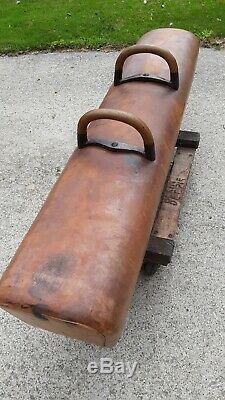
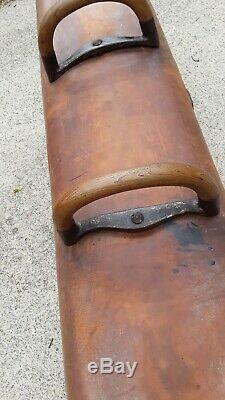
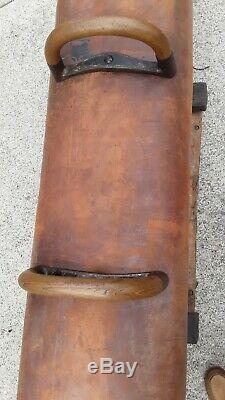
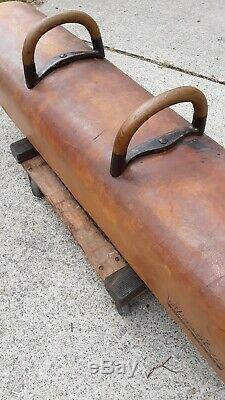
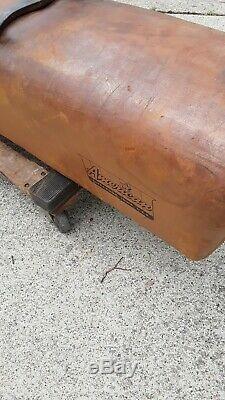
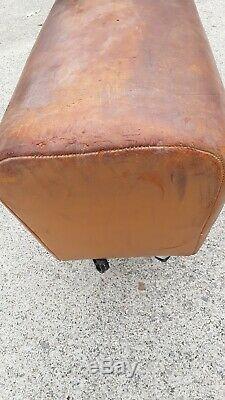

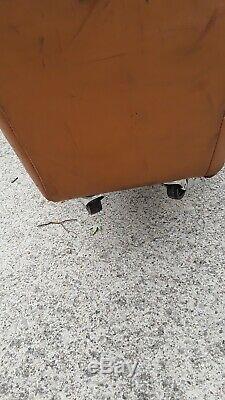
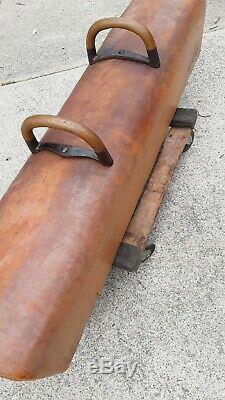
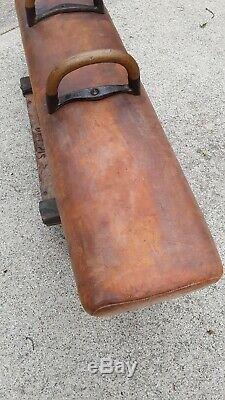
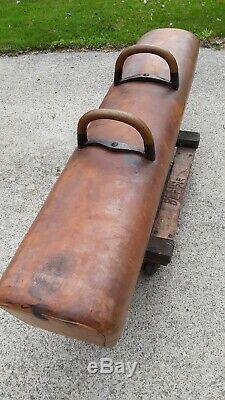


German Handles 1930s made from metal and wood. Horse is 5' 4" long, 14" wide. 4 Swivel casters at each corner make it easy to move.
Great for the end of a bed or to store your treasures on. Loft or man cave decor piece.
Men's artistic gymnastics pommel horse began as a practice proxy for the actual, living animal: equus caballus. The history of the pommel horse goes as far back as Alexander The Great and his Macedonian soldiers who used an early pommel horse to practice mounting the beasts they would ride into battle somewhere around 315 BC. The early pommel horse did not have the handles or pommels we see today in men's gymnastics competition. Nor, did it offer the comfort of padding and leather. Instead, it was a simple wooden structure modeled after the animal's back where the rider would sit. The Roman army, also, used the ancient predecessor to today's sports pommel horse for practice mounting and dismounting living horses employed in military maneuvers. Gymnastics as a whole has a long history of influence on the military and vice versa, as the sport became a way for soldiers to develop the physical conditioning and dexterity for hand-to-hand combat. In history, and in the military, the pommel horse resurfaces in the efforts of the knights of the 17th century who took to the form to improve theirs, as they practiced for and engaged in horse ridden battles and sporting events: pommel horse equestrianism gains a strong foothold in both up until the late 18th century.Enter: Friedrich Ludwig Jahn, a German and a former member of the Prussian military. Jahn is widely regarded as the father of modern gymnastics.
Though gymnastics itself enjoyed a much earlier beginning in the Greek Olympic games, it was, at one point outlawed in those ancient times, and therein abandoned by much of the world until revived by Jahn in the 19th century. Prussian defeat by Napoleon had left Jahn's native country in poor spirits. His surviving writings reveal that he thought a return toward physical vigor and mental prowess through the practice of gymnastics would set his countrymen on the higher path. He is said to have opened the first gymnastics club, The Turnplatz, which was an open air gymnasium dedicated to the sport. From Jahn's time onward until 1936, the pommel horse took many forms which more and less mimic the uneven planes and curves of the actual four-legged animal to the symmetrical planes that more closely resemble the gymnastics pommel horse we see today. An asymmetrical, more horse like shape was found to be more difficult for male gymnasts to engage in wandering type movements becoming more popular in the sport of gymnastics, though they did still attempt them on the sloping shaped pommel horses. Com, A 1926 model of the pommel horse had a more sleek look to the torso and the lower part slightly curves upwards. This type of horse was still used at the 1936 Berlin Olympics. It was only 71 inches (180cm) long.Gymnasts already competed swinging elements on the neck as well as the rump. It wasn't until the Americans introduced their fully symmetrical version in 1948, that we see today's form take shape and solidify as the gymnastics standard.
The 63 inch (160cm) fully symmetrical pommel horse was certified by the International Gymnastics Federation in 1956. "But, what about the pommel's, " you ask? Their appearance depended on the intended use and user of the horse, itself. If the horse was employed for military practice or equestrian acrobatics, the pommels offered little benefit.
When intended for gymnastics, the raised handles or pommels, offered the gymnast more opportunities for support and variation of movements, transitions and combinations. Gymmedia offers details, But once gymnasts began swinging in the support position - first with one leg, and in the middle of the 19th century the two-legged swing became popular- this influenced the form of the pommels. Swiss gymnastics was particularly progressive during this period and in the 1880s the pommel horse spread into German gym clubs as well. The standard pommel was hollow, mostly made from iron in the beginning, but in later years wood was also used. Some of the pommels were covered in leather. The pommels of the horse used at the 1936 Olympics were noticeably flatter in comparison to the earlier ones. As with most pieces of equipment, artists and their technique had a significant influence on their development. Pommel horse gymnastics greats like Grant Schaginjan and Yu Lifeng of China, with his circles on one pommel at the 1962 world championships in Prague, or pommel horse specialist Russel Mills, who showed circles in cross support on one pommel in 1964. Then, of course, the list continues with Miroslav Cerar, Zoltan Magyar. The call for pommels that allowed for a fleeting double hold/grip at an equal height of the pommels became louder and louder. Today, we manufacture our pommel horse to FIG standards. The pommel handles you see pictured here are from, we estimate, the 1920's or'30's. The item "Pommel Horse Gymnastic Leather Bench Seat Desk Stool Handle Decor Sport Vintage" is in sale since Sunday, July 21, 2019.This item is in the category "Sporting Goods\Team Sports\Gymnastics\Equipment". The seller is "12rower12" and is located in Clinton Township, Michigan. This item can't be shipped, the buyer must pick up the item.

